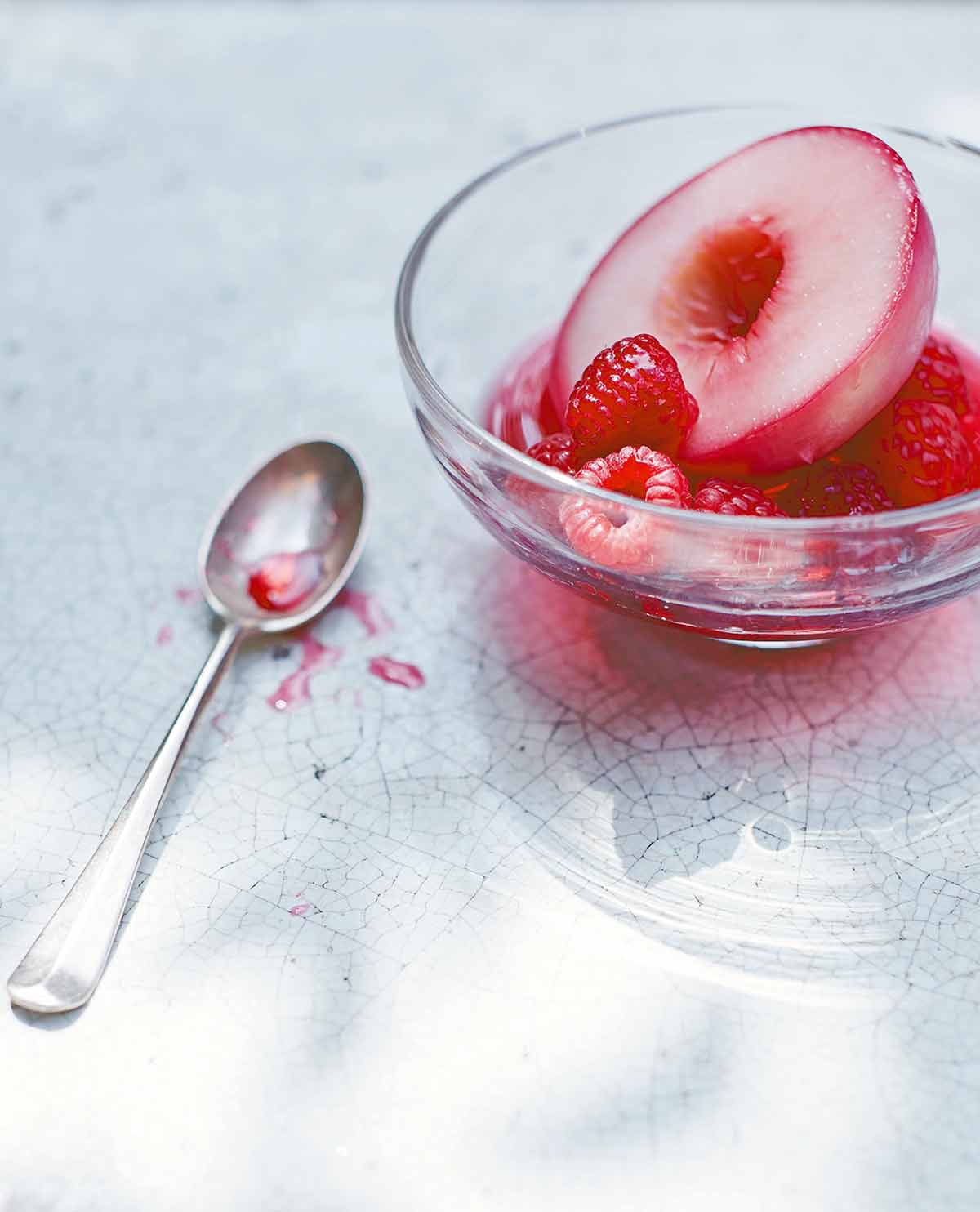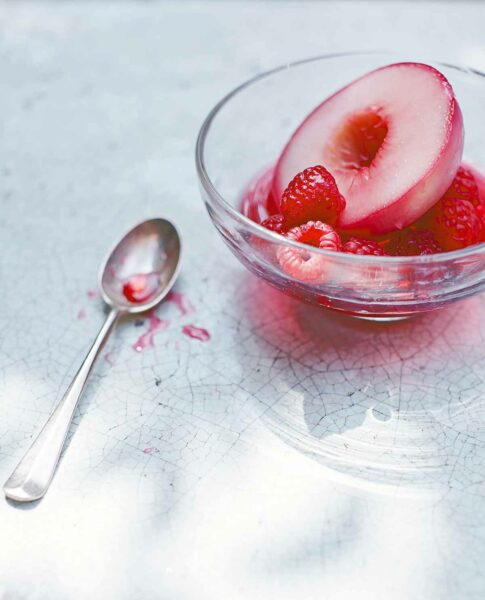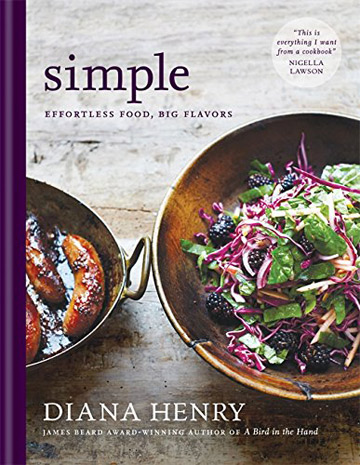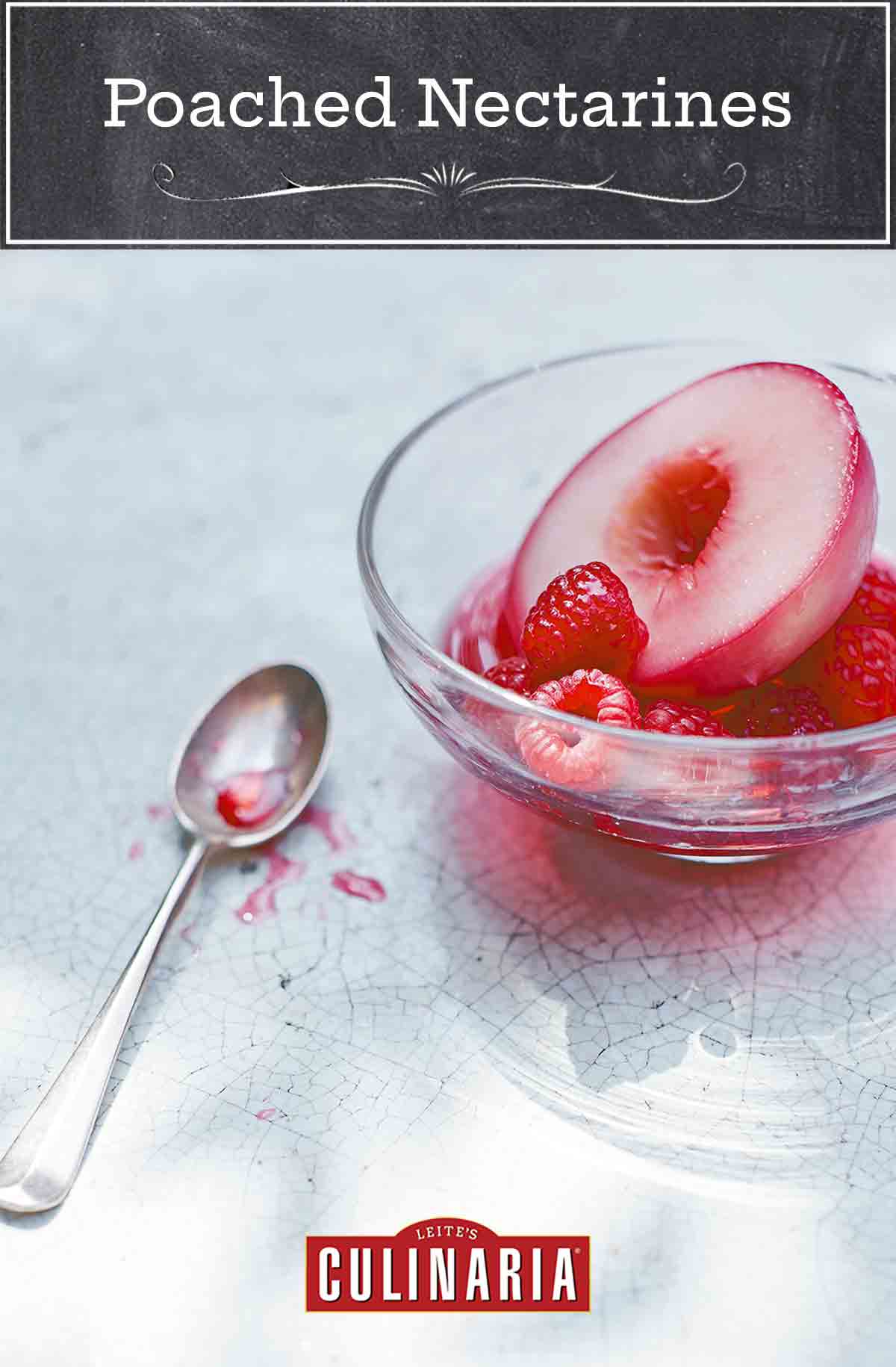
Stunning. That’s what we think of these poached nectarines, a simple yet spectacular late-summer dessert for grown-ups. The recipe is an almost embarrassingly simple equation of sweetly tart stone fruits simmered in wine and sugar that yields a taste that’s far more complex than you’d imagine. Of course, there’s no need to tell guests just how little effort it took.–Renee Schettler
CAN I POACH DIFFERENT STONE FRUIT?
It’s tempting to try this lovely poached nectarines recipe with other stone fruits. Author Diana Henry fancies the slight tartness and fragrance of white nectarines for this particular combination of ingredients, which tempers the tart with a sweet wine syrup. Although she concedes that in a pinch, white peaches work as a capable stand in. Beyond that, tempting though it may be, plums and pluots lack the requisite delicateness for poaching and their more robust flavor fights with the nuanced rosé syrup.

Poached Nectarines
Ingredients
- 2 1/2 cups rosé wine
- 1 cup plus 2 tablespoons granulated sugar (or less if your sweet tooth is minimally sweet)
- 2 strips lemon zest, preferably organic (each about 1/2 inch wide by 1 1/2 inches long)
- Juice of 1/2 small lemon (about 1 tablespoon)
- 6 ripe white nectarines (or substitute white peaches), halved and pitted but not peeled
- 1 1/2 cups raspberries
Instructions
- Grab a saucepan or stock pot that's large enough to hold all the halved nectarines or peaches in a single layer. Add the wine, sugar, lemon zest, and juice, bring to a boil, and stir until the sugar dissolves while you pour what's left of that bottle of rosé into a glass and leisurely sip it.
- When the sugar is completely dissolved, reduce the heat beneath the rosé syrup to medium-low and add the nectarines. Very gently simmer the nectarines, uncovered, carefully turning them over every so often, until they're tender throughout, 8 to 12 minutes. Check for doneness by piercing the nectarines with the tip of a paring knife. You want the knife to slip in easily but with a touch of resistance because the nectarines will continue to soften slightly after they're removed from the liquid. The exact timing will depend on just how ripe your nectarines. Use a slotted spoon or tongs to remove each nectarine half as it’s ready and place it on a rimmed baking sheet to cool slightly.
- When all the nectarines have been removed from the rosé, increase the heat to medium and simmer until it’s reduced and slightly syrupy and either measures 1 to 1 1/2 cups, about 10 minutes. The intensity of the flavors will intensify the longer you simmer the syrup. Be careful to take a sip occasionally and be careful not to reduce it to the point where it tastes like cough syrup. Turn off the heat and let the syrup cool to room temperature. The syrup will thicken more as it cools.
- Meanwhile, if peeled nectarines are desired, using your fingertips, carefully slip the skin from the nectarines. If the skin adheres, grab a paring knife, place the tip beneath the edge of the skin, and gently tug.
- Place the poached nectarines in a serving dish and pour in the rosé syrup. Cover and refrigerate for at least 15 minutes and up to 24 hours.
- Just before serving, gently stir in the raspberries and coat them with the syrup, being careful not to crush the berries. Spoon the nectarines, raspberries, and syrup into small dishes.

Explore More with AI
Nutrition
Nutrition information is automatically calculated, so should only be used as an approximation.
Recipe Testers’ Reviews
I am obsessed with stone fruits this time of year! No matter the type—peaches, nectarines, plums, apricots, pluots. I enjoy stone fruits each and every day, either raw or poached as in this lovely recipe. Nectarines specifically are juicy and perfectly sweet. Gently poached in a pot of sweetened rosé wine flavored with a touch of lemon, the flavor combination of the sweet nectarines in the chilled wine is perfectly offset by the last-minute addition of tart raspberries.
I liked the fact that the nectarines were poached but that you leave the raspberries uncooked and just stirred into the finished product. I used a nice sprig of mint from the garden to finish off each serving. I adored this elegant recipe and so did my dinner companions! Light and perfect for summertime.
Select a Tester
I am no stranger to boozy fruit, which is what I dub fruit that’s simply simmered in wine and sugar until suffused with loveliness. Although I have to say, these poached nectarines are easily one of the most simple and stunning renditions I’ve experienced. The white nectarines not only look gorgeous against the pale pink syrup but their slight tartness keep the dessert from becoming too sweet, which I think could easily happen if using regular yellow peaches.
The reduced rosé wasn’t cloying nor overly alcoholic. It was simply lovely and tasted a lot more complex than something with two ingredients. My nectarines were just shy of ripe and not overly sweet, so I omitted the lemon and didn’t miss it at all. Actually, I also omitted the raspberries because they were crazy expensive. I didn’t feel anything was lacking from the dessert. The fussiest part of the recipe was slipping the skins off the nectarines while keeping the fruit intact and pretty enough for guests.
I”ll be making this recipe again and again and again, and in the future I intend to toss in some black peppercorns, a cinnamon stick, some cardamom pods, or a couple star anise, depending on my mood, in place of the lemon zest. It’s also a stunning make-ahead dessert for gatherings that would actually be lovely at a backyard barbecue after the heaviness of smoked ribs or pulled pork. A keeper.
This very pretty late-summer dessert is a good method for taking advantage of the best of the season. Nectarines can give you a firm but flavorful stone fruit. Though their tartness will vary quite a bit and I think for this recipe to work best you need to take that in consideration, tasting your fruit and adjusting the sweetness of the syrup as necessary–a tart batch of fruit would be better with the recipe amount of sugar but use less if your fruit is sweeter but lacks acid.
I chose firm fruit, and was cautious about overcooking, as mentioned in the recipe, but it took close to half an hour for the centers of the nectarines to become somewhat fork tender in their center. Peaches so readily give up their skin, but these stubbornly held on, so I served it as pictured, with the skin. This is a sweet dessert when served at room temperature, although when well chilled it may be just right.
The rosé is very subtle, not the flavor you might get with a red wine or even some whites, but I think that is because of the amount of sugar. I would reduce that by half if making this again. It keeps well for several days, so I added just enough raspberries when serving. This also pairs nicely with homemade vanilla ice cream if you are inclined, and the extra syrup will work as a simple syrup over ice cream or in drinks.
While I might like the brighter flavours of nectarines in a rose sangria, I think most people like a sweet and delicate dessert and this is nice enough to serve guests. The lemon strips candied beautifully and were a nice bonus. If you leave the skins on, it would be useful to slice them before serving.













I was making dessert for two diabetics, so subbed Splenda for all the sugar. I purchased ripe white-fleshed nectarines a couple of days earlier than I poached them … they were getting a little over-ripe at that point, so same-day buying and baking would be better. Also – how the heck do you get pretty halves from fruit that clings to the pit?? I was an abysmal failure at it. But I prepared the nectarines anyway, and served them sliced in bowls, sprinkled raspberries and poured syrup over. Everyone loved this! Delicately sweet syrup (not thickened, so a little watery consistency that people drank from their bowls!). Very nice – thank you for a different summertime dessert for company!
You’re welcome, Nana’s Girl. That sounds spectacular, and you definitely did the right thing by slicing them! Freestone nectarines aren’t always easy to find.